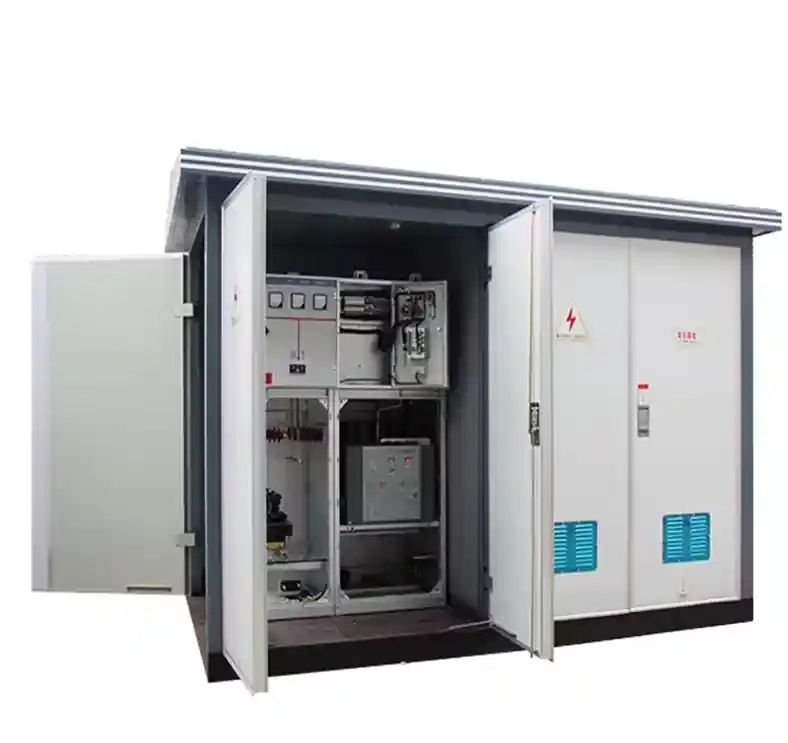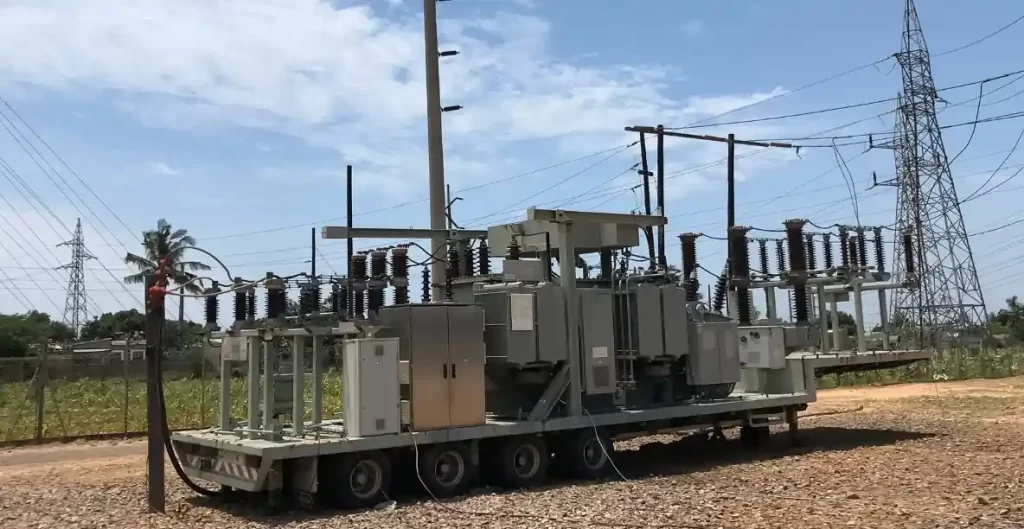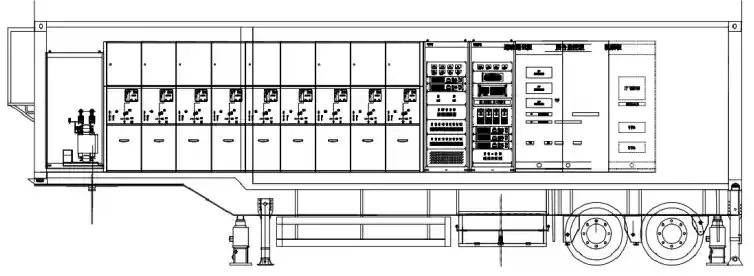No mundo da distribuição de energia elétrica, subestações temporárias desempenham um papel fundamental na manutenção da estabilidade da rede, apoiando a continuidade do projeto e garantindo um serviço ininterrupto durante interrupções ou transições. Sejam elas implantadas durante situações de emergência, grandes obras de construção ou como um paliativo durante atualizações permanentes da infraestrutura, essas subestações são projetadas para rápida implantação, flexibilidade e desempenho em condições dinâmicas.
O que é uma subestação temporária?
A temporário subestação é uma instalação de energia móvel ou semipermanente projetada para executar as mesmas funções fundamentais de uma subestação permanente - transformar os níveis de tensão, permitir a comutação e garantir a proteção dos sistemas elétricos. Entretanto, ao contrário das subestações fixas, as temporárias são pré-fabricado, modulare projetado para implantação e remoção rápidas.
Normalmente, eles incluem:
- Painel de distribuição de média ou alta tensão
- Transformadores de potência (por exemplo, 11kV/33kV a 400V/230V)
- Sistemas de proteção e controle
- Gabinetes móveis ou plataformas montadas em reboques

Áreas de aplicação de subestações temporárias
As subestações temporárias são amplamente utilizadas em cenários em que a agilidade, a velocidade e a mobilidade são essenciais:
- Projetos de construção: Para fornecer energia a locais de construção ou infraestrutura em grande escala
- Manutenção da rede de serviços públicos: Energia de reserva durante atualizações ou reparos de subestações
- Ajuda em caso de desastres: Energia de emergência em resposta a desastres naturais ou quedas de energia
- Eventos e festivais: Fornecimento temporário de eletricidade para locais ao ar livre
- Instalações industriais remotas: Operações de mineração, campos de petróleo e plataformas de perfuração móveis

Tendências de mercado e histórico
De acordo com relatórios recentes da IEEMA e Informações sobre o mercado global de subestaçõesNa América Latina, a demanda por subestações temporárias está aumentando acentuadamente devido aos investimentos crescentes em infraestrutura, ao aumento das atividades de modernização da rede e à expansão da área de cobertura dos projetos de energia renovável.
O IEEE também reconhece o celular guia de subestações elétricas como parte fundamental do infraestrutura de energia resistente a desastres-especialmente em regiões propensas a eventos climáticos extremos. Fabricantes líderes como ABB, Schneider Electrice Siemens estão desenvolvendo soluções compactas e inteligentes com recursos como monitoramento remoto, Diagnósticos baseados em IoTe Integração SCADA.
Veja mais definições técnicas em Wikipedia - Subestação elétrica.
Especificações técnicas
Uma subestação temporária padrão pode ser personalizada com base no nível de tensão e nos requisitos de capacidade. Veja abaixo uma configuração típica:
| Componente | Exemplo de especificação |
|---|---|
| Classificação da tensão | 11kV / 22kV / 33kV primário |
| Capacidade do transformador | 500 kVA - 5 MVA |
| Tensão secundária | 400V / 230V |
| Mobilidade | Montado em reboque ou em contêiner |
| Sistema de resfriamento | ONAN ou ONAF |
| Tipo de gabinete | IP54-IP65, adequado para uso externo |
| Padrões | IEC 60076, IEC 62271, IEEE C57 |

Comparação: Subestações temporárias vs. permanentes
| Aspecto | Subestação temporária | Subestação permanente |
|---|---|---|
| Tempo de implantação | Dias a semanas | Meses a anos |
| Custo | Menor valor inicial; opções de aluguel | Maior investimento de capital |
| Flexibilidade | Alta (realocável) | Local fixo |
| Duração do serviço | Uso de curto a médio prazo | Infraestrutura de longo prazo |
| Manutenção | Menor complexidade | Sistemas mais robustos |
Embora não sejam projetadas para operação de longo prazo, as subestações temporárias são frequentemente usadas durante as fases de comissionamento ou renovação de grandes projetos de energia.
Dicas de seleção: Escolhendo a subestação temporária certa
Ao selecionar uma subestação temporária, tenha em mente o seguinte:
- Requisitos de carga: Faça uma estimativa da corrente e das cargas de pico para corresponder à classificação do transformador.
- Necessidades de mobilidade: A montagem em reboque é ideal para realocação frequente.
- Condições ambientais: Certifique-se de que a unidade possa suportar poeira, umidade ou temperaturas extremas.
- Compatibilidade com a grade: Combine a tensão de entrada/saída e os esquemas de proteção com a rede local.
- Suporte ao fornecedor: Escolha fornecedores que ofereçam instalação no local, comissionamento e assistência técnica.
Marcas de renome como PINEELE, ABBe Eaton oferecem soluções de aluguel e prontas para uso com total conformidade com IEC e IEEE padrões.
Referências confiáveis
- Série IEEE Std C37™: Proteção e controle para subestações
- IEC 62271-202: Subestações HV/LV pré-fabricadas
- ABB White Paper: Subestações móveis para energia temporária e de emergência
- Wikipedia - Tipos de subestações
Essas referências oferecem validação técnica e o histórico necessário para engenheiros de infraestrutura e equipes de aquisição.
Perguntas frequentes
A: Dependendo das condições do local, uma subestação temporária pode ser instalada e comissionada dentro de 3 a 10 dias, em comparação com meses para soluções permanentes.
A: Sim. Quando projetado por IEC ou IEEE incluem gabinetes aterrados, proteção contra arco e mecanismos de disparo automático.
A: Embora não tenham sido projetadas para uso permanente, algumas unidades modulares podem ser atualizadas ou integradas a configurações permanentes com suporte adicional de engenharia.
A temporário Guia da subestação é uma solução versátil e de rápida implementação, ideal para atender às necessidades de distribuição de energia de curto a médio prazo. Esteja você enfrentando um desastre natural, passando por atualizações de instalações ou alimentando um local industrial remoto, esse tipo de subestação oferece confiabilidade, escalabilidadee conformidade com padrões globais.


